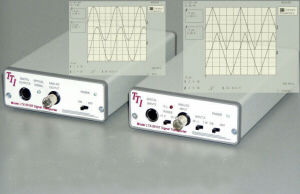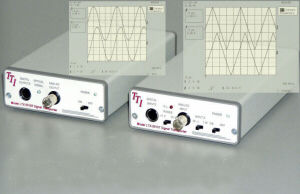
- Robotics - Automation - Industrial IT
- Automation
- Analog converter
- Scitec Instruments
Optical-electrical converter TIA-952 seriesanalogfiber optics
Add to favorites
Compare this product
Characteristics
- Type
- analog, optical-electrical
- Bus
- fiber optics
Description
Features
• Large Area InGaAs detector
• 800 MHz Analog Bandwidth
• Selectable Gain Settings
• Universal Power Supply
• Capability to drive 50 Ohm output loads
• For use for Single or Multi Mode Fibers
Applications
• General laboratory testing of optical components
• Field Service Testing and Troubleshooting
• Laser alignment and tuning
• Plasma physics measurements
The TIA-952 optical receiver is a convenient, easy to use O/E converter. It is extremely useful in a variety of laboratory, factory and field service situations where a quick check of the operation of a laser source, optical transmitter or the throughput of a fiber optic communications link is required. The unit conveniently mounts directly on the vertical input BNC connector of your oscilloscope, digitizer or other readout device.
The large area Indium-Gallium-Arsenide detector provided is optimized for use with both single mode and multi mode fibers and covers the 900 to 1700 nm spectral region. Gains are switch selectable and provide peak responsivity values of approximately 500 and 2500 volts per watt. The electrical bandwidth of the TIA-952 exceeds 800 MHz using the low gain setting and exceeds 300 MHz in the high gain mode.
The unit's output stage is fully capable of driving a 50 ohm coaxial cable terminated in its characteristic impedance. Fiber connector options include either ST or FC receptacles. Powered by a universal wall mount power supply (90 - 260 VAC, 50-60 Hz with four mains adaptors), the TIA-952 is handy to use and store.
Catalogs
No catalogs are available for this product.
See all of Scitec Instruments‘s catalogsRelated Searches
- Transceiver module
- Fiber optic transceiver module
- Single-mode transceiver module
- Optical fiber converter
- Digital IC converter
- Analog IC converter
- Analog transceiver module
- Bidirectional transceiver module
- Fast IC converter
- Single-mode converter
- High-speed IC converter
- TTL converter
- Optical-electrical converter
- CMOS converter
- 16-channel transceiver
*Prices are pre-tax. They exclude delivery charges and customs duties and do not include additional charges for installation or activation options. Prices are indicative only and may vary by country, with changes to the cost of raw materials and exchange rates.













